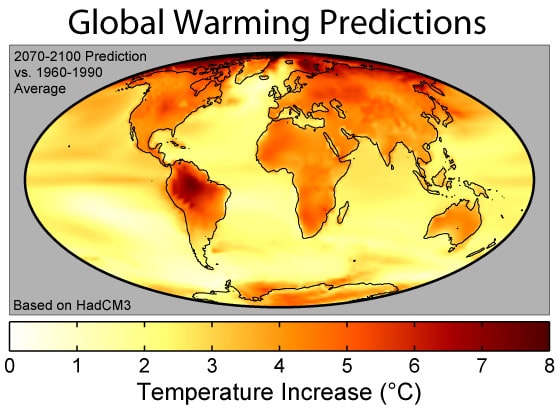Introduction of Global Warming
Global Warming – Our Globe is getting warmer as the temperature of the Earth has been continuously rising for decades to come, largely due to the uncontrolled and unregulated emission of greenhouse gases in the atmosphere produced by human activities. Here we are going to find out What is Global Warming?, Its Causes and Effects.

Global Warming, also known as Climate Change, has increased the average temperature of the Earth’s climate system. Global surface temperatures are likely to rise from 0.3 to 1.7 degrees Celsius in the lowest emission scenario and 2.6 to 4.8 degrees Celsius in the highest emission scenario. These readings are recorded by the ‘National Science Academies of Major Industrialized Countries’. Global Warming and its likely impacts will vary from region to region in the future. Some of the expected impacts include rising global temperatures, rising sea levels, changing rainfall patterns, expansion of deserts, etc.
The most noticeable change due to this increase in temperature is the melting of polar ice caps on a worldwide scale. The sea level is constantly rising as the continental ice is melting into the sea. Most of the cities have been facing the flooding situation owing to the rising sea level.
Effects of Global Warming
Sea Level Rise
Sea level rise (SLR) is one of the most severe impacts of climate change, with small island countries and coastal areas being at the risk of rising water levels by the end of the century.
At the same time, SLR is an effect with the largest uncertainties, with various studies estimating widely different ranges in the 21st century.
The Earth’s oceans have already risen by about 0.2 m since the late 1800s, with SLR rates accelerating in recent decades. In 2013, the Fifth Assessment Report (AR5), The Intergovernmental Panel on Climate Change (IPCC) estimated that SLR is unlikely to rise by 1 m this century, even though emissions were very high.
Heat Waves
Worldwide, warmer days are getting warmer and more frequently, given the less cold days. The US Heat waves are going to be common in the West, and the symptoms of intense heat are more frequent, although many parts of the country still experience higher frequencies of heat waves (due to the dust bowl and other factors).
Droughts
Drought primarily occurs in dry areas. In drier areas, higher evaporation rates can result in periods of drought which can be characterized by a lack of adequate soil moisture in agricultural areas. Southern Africa, the Sahel region of Africa, Southern Asia, the Mediterranean and the American Southwest, for example, are drying up. Even areas that remain relatively wet can experience long, dry conditions between extreme rainfall events.
Heavy Rainfall with Floods
As the atmosphere warms, it can hold more moisture. The intensity (and therefore flood risk) of downpours depends on the part of how much water the air can hold in a given time.
As the world warms, the rate of evaporation from the sea is increasing. Think of heating a large pot of water on your stove – the more you turn the dial, the faster the water evaporates. Much the same happens with the planet, and globally, this high rate of evaporation contributes to more extreme rainfall and snow events.
Heavy Snowfall
As the climate increases, evaporation from the sea increases. This creates more water vapor in the air. Globally, atmospheric water vapor has increased by about 5% in the 20th century. Most of the increase has occurred since. This has been confirmed by satellites that find that total atmospheric moisture content has been increasing since measurements began in 1988.
Causes of global warming
Urbanization
Both global warming and urbanization can enhance warming in cities and their surroundings. Night-time temperatures are more affected by this effect than daytime temperatures due to the Heat Island effect. Increased urbanization can also intensify extreme rainfall events over the city or downwind of urban areas.
Land Degradation
A major portion of the Earth’s ice-free land area is subject to human-induced degradation leading to soil erosion from agricultural fields with an estimated level of 10 to 20 times to more than 100 times higher than the soil formation rate Climate change exacerbates land degradation, particularly in low-lying coastal areas, river deltas, drylands and in permafrost areas. People living in already degraded or desertified areas are increasingly negatively affected by Global Warming (climate change).
Growing Population
The increasing global population which in turn, changes the per capita consumption of food, feed, fiber, timber and energy have caused unprecedented rates of land and freshwater use with agriculture currently accounting for 70% of global fresh-water use. Expansion of areas under agriculture and forestry, including commercial production, and enhanced agriculture and forestry productivity has supported consumption and food availability for a growing population. With the large regional variation, these changes have contributed to increasing net GHG emissions, loss of natural ecosystems (e.g. forests, savannahs, natural grasslands and wetlands) and declining biodiversity.
Over Exploitation of Land Resources
Land provides the basis for many of the ecosystem functions and services like the production of food, feed, fiber, timber and energy, including cultural and regulating services that are essential for humanity. Burning of fossil fuel like coal and wood contributes to the release of CO2 gas in the atmosphere similarly the cultivation of paddy fields releases the methane gas into the atmosphere.
Solutions
Smart Vehicular Choice: Reducing vehicular emission means that we need to choose a hybrid car that reduces the pollutant emission. If a person works daily, he/she needs to refuel his/her car every alternate week (on average, depending on the commutation distance) thus causes carbon dioxide emission and depletion of fossil fuels. Yet another way to reduce the consumption of petroleum is to use public transport or carpool. This can help reduce carbon dioxide and save costs.
Recycling: Recycling can reduce waste by reusing plastic bags, bottles, papers or glasses. Another example is after drinking water from a bottle we can reuse it or use our own bottle. If all of this is being reused, it can help to a larger extent in eliminating global warming.
Finally, we should refrain from burning our waste products in an open area such as burning of dry leaves or burning of garbage as incomplete combustion of plastic waste leads to the release of harmful gases like Carbon Dioxide, Carbon Monoxide, and Sulphur Dioxide, etc.
Another important measure to combat global warming is by planting more trees and increasing the green cover of the Earth as it would countify the ill effects of the deforestation and release of harmful gases in the atmosphere. In addition, the government should plan alternate measures for reducing and checking the rate of deforestation as, without the green cover, the temperature of the earth is increasing. Trees, in turn, help in improving the temperature on Earth.

She is a Conservation Biologist deeply concerned with the protection and sustainability of natural resources and wildlife. She is particularly interested in studying and addressing the loss of Biodiversity and educating the people about the same. She has a Master’s degree in Zoology with Post Graduate Diploma in Environment and Sustainable Development and another in Sustainability Sciences.

Pingback: World Environment Day 2020: Theme - The Mighty Earth
Can I share your work with my peers.?
Thank You for visiting our website.
We are glad to know that our efforts are being noticed and are acclaimed.It would be our pleasure if you could share our work within your network as well.
Please do visit our website regularly for new contents on various Environmental issues and concerns.
Once again
Thank You
Pingback: Solid Waste Management - The Mighty Earth